
The mimids are the New World family of passerine birds, Mimidae, that includes thrashers, mockingbirds, tremblers, and the New World catbirds. As their name suggests, these birds are notable for their vocalization, especially some species' remarkable ability to mimic a wide variety of birds and other sounds heard outdoors. They are commonly referred to as mimic thrushes but are not, in fact, thrushes.

In evolutionary biology, mimicry is an evolved resemblance between an organism and another object, often an organism of another species. Mimicry may evolve between different species, or between individuals of the same species. In the simplest case, as in Batesian mimicry, a mimic resembles a model, so as to deceive a dupe, all three being of different species. A Batesian mimic, such as a hoverfly, is harmless, while its model, such as a wasp, is harmful, and is avoided by the dupe, such as an insect-eating bird. Birds hunt by sight, so the mimicry in that case is visual, but in other cases mimicry may make use of any of the senses. Most types of mimicry, including Batesian, are deceptive, as the mimics are not harmful, but Müllerian mimicry, where different harmful species resemble each other, is honest, as when species of wasps and of bees all have genuinely aposematic warning coloration. More complex types may be bipolar, involving only two species, such as when the model and the dupe are the same; this occurs for example in aggressive mimicry, where a predator in wolf-in-sheep's-clothing style resembles its prey, allowing it to hunt undetected. Mimicry is not limited to animals; in Pouyannian mimicry, an orchid flower is the mimic, resembling a female bee, its model; the dupe is the male bee of the same species, which tries to copulate with the flower, enabling it to transfer pollen, so the mimicry is again bipolar. In automimicry, another bipolar system, model and mimic are the same, as when blue lycaenid butterflies have 'tails' or eyespots on their wings that mimic their own heads, misdirecting predator dupes to strike harmlessly. Many other types of mimicry exist.

The mimic octopus is a species of octopus from the Indo-Pacific region. Like other octopuses, it uses its chromatophores to disguise itself. It is noteworthy for being able to impersonate a wide variety of other marine animals. While many animals mimic either their environment or other animals to avoid predation, the mimic octopus and its close relative the wunderpus are the only ones known to actively imitate several animals in order to elude predators.

In the Dungeons & Dragons fantasy role-playing game, the mimic is a type of fictional monster. It is portrayed as being able to change its shape to disguise its body as an inanimate object, commonly a chest. The mimic uses a powerful adhesive that holds fast to creatures that touch it, allowing the mimic to beat its victims with its powerful pseudopods. The mimic was introduced in the first edition Advanced Dungeons & Dragons game's original Monster Manual. The mimic has appeared in subsequent editions. Several variants of the creature have been introduced, with a variety of abilities and sizes.

Dismorphiinae, the mimic sulphurs, is a subfamily of butterflies from the family Pieridae. It consists of about 100 species in seven genera, distributed mainly in the Neotropical region, of which only one species occurs in North America and one genus, Leptidea, is in the Palaeartic region.

Müllerian mimicry is a natural phenomenon in which two or more well-defended species, often foul-tasting and sharing common predators, have come to mimic each other's honest warning signals, to their mutual benefit. The benefit to Müllerian mimics is that predators only need one unpleasant encounter with one member of a set of Müllerian mimics, and thereafter avoid all similar coloration, whether or not it belongs to the same species as the initial encounter. It is named after the German naturalist Fritz Müller, who first proposed the concept in 1878, supporting his theory with the first mathematical model of frequency-dependent selection, one of the first such models anywhere in biology.

Papilio polytes, the common Mormon, is a common species of swallowtail butterfly widely distributed across Asia.

Jatrorrhizine is a protoberberine alkaloid found in some plant species, such as Enantia chlorantha (Annonaceae). Synonyms that may be encountered include jateorrhizine, neprotin, jatrochizine, jatrorhizine, and yatrorizine.
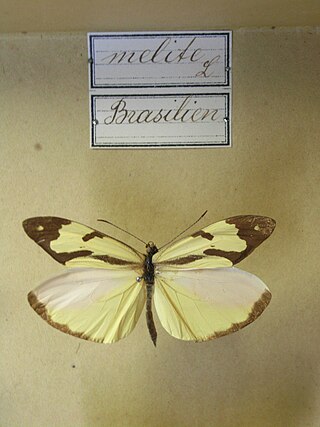
Enantia is a genus of butterflies in the subfamily Dismorphiinae. They are native to the Americas.

Lieinix is a genus of butterflies in the subfamily Dismorphiinae. It is native to the Americas.

Enantia melite is a species of butterfly that is found from Central America to the Amazon Basin. It has a wingspan of 48–52 millimetres (1.9–2.0 in), and is very variable. It lives in cloud forest and transitional forest, at altitudes of 400–1,800 metres (1,300–5,900 ft).
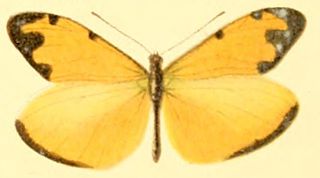
Enantia albania, the costa-spotted mimic-white, is a butterfly in the family Pieridae. It is native to tropical Mexico and Central America, but rare strays have been reported from the Lower Rio Grande Valley in Texas. The habitat consists of low- to mid-elevation tropical forests and coffee plantations.

Lieinix nemesis, the frosted mimic-white, nemesis mimic white or falcate dismorphia, is a butterfly in the family Pieridae. It is found from Mexico to Peru. The habitat consists of mid-elevation cloudforests.
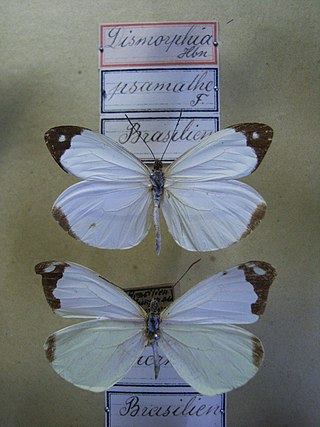
Enantia lina, the white mimic white or lina mimic white, is a butterfly in the family Pieridae. It is found from Mexico to most of South America.

Enantia limnorina is a butterfly in the family Pieridae. It is found in Brazil. The species was first described in 1865 by C. & R. Felder as Leptalis limnorina.
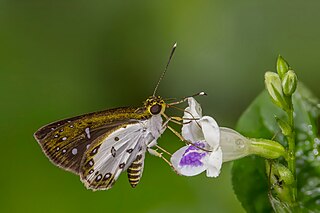
Ceratrichia nothus, commonly known as the white-winged forest sylph, is a species of butterfly in the family Hesperiidae. It is found in Guinea, Sierra Leone, Liberia, Ivory Coast, Ghana, Togo, Nigeria, Cameroon, Equatorial Guinea and the Central African Republic. The habitat consists of wetter forests.
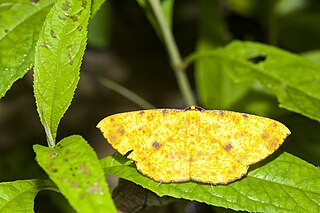
Eumelea ludovicata is a species of moth in the family Geometridae first described by Achille Guenée in 1858. It is found in Indo-Australian tropics of India, Sri Lanka, east to Singapore, Taiwan, the Solomon Islands and Guam.

Annickia chlorantha is a tree that grows up to 25 meters tall, it belongs to the Annonaceae family. An important tree used in traditional medical practices for the treatment of malaria and various diseases in Nigeria and Cameroon; oil extracted from stem barks and leaves of the species and Annickia affinis, its more common close kin have been widely studied.














